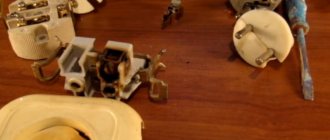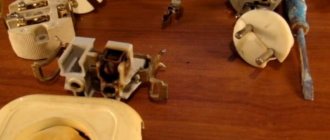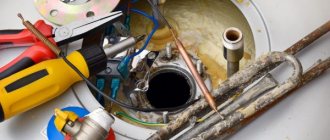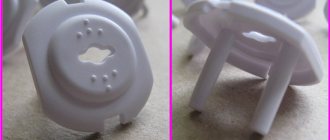The socket sparks because the plug does not fit
The most common reason that an outlet sparks is that the plug does not match the standards. Many people have had sockets since the construction of the house or the last renovation. And this is often 10 or even 20 years. At that time, these products were manufactured for electrodes with a diameter of 4 mm. Modern forks have a fork diameter of 4.8 mm. As a result of this discrepancy, it turns out that a thicker plug stretches the contacts in the socket. When you turn on a device that has 4 mm electrodes, the contact is insufficient, and therefore the socket sparks.
The main reasons for sparking sockets
There are not so many reasons why an outlet sparks, among them:
1. Most often, it is a weakened connection that causes sparking . In most modern sockets, screw terminals are used to connect the wires of the input electrical cable, which, according to the regulations, must be periodically tightened, otherwise the exposed wire will no longer fit tightly to the contacts and sparking will occur.
2. If the operating mode of the outlet is violated, when currents pass through it for which it is not designed, the outlet becomes very hot . In this case, the connection point of the conductors may burn, oxidize, etc. and the reliability of contact decreases. For example, this happens when several powerful consumers are simultaneously connected to an outlet through a tee.
Poor-quality connectors in sockets can become loose over time and become loose around the pins of the electrical plug. In addition, low-quality alloys may have been used in their manufacture, which weaken or oxidize over time.
3. Poor quality or non-standard electrical plug. Often, the pins of an electrical plug are smaller in size than they should be or they are made of low-quality, unsuitable alloy, which over time or immediately leads to sparking.
But what does such sparking threaten us with, is it dangerous at all or is it just an additional “effect” of the operation of an electrical appliance, let’s figure it out together.
Socket sparks due to overload
A socket, like, in principle, any other household appliance, has certain characteristics and parameters. Each product is marked accordingly. For example, a 16 A and 250 Volt outlet can withstand a load of 3.5 kW.
- 6 Amps – 1.3 kW
- 10 Amps – 2.2 kW
- 32 Ampere – 7 kW
Exceeding the maximum permissible loads will lead to overheating of the socket contacts. As a result, they burn and resistance increases. Based on this, we can conclude that a large number of extension cords and overly powerful devices cannot be plugged into one outlet.
Why does the socket spark when you insert a plug: reasons
Possible reasons why the socket sparks when you insert a plug are as follows:
- current reboot;
- poor contact due to loosening of the plug clamps;
- using a Euro socket in combination with an old-style plug;
- operational wear of the socket.
Why is the washing machine electrocuted?
Connecting switched on devices, current reboot
Let's look at the situation with switched on devices using a specific example. Absolutely every household appliance in the modern world, be it a TV, a kettle or a bread machine, has a power button. When the button is in the on position, a spark may form when the plug is inserted into the socket, the strength of which is directly proportional to the power of the device. But there are electrical appliances that do not have on/off buttons; then, to avoid sparking problems, de-energize the outlet (turn off the power supply), insert the plug of the device into the outlet and apply voltage. The plug socket has its own characteristics of acceptable connection parameters. That is, if the device that you want to connect to the electrical network has a permissible current of 3.50 A. Or several devices, but the total does not exceed this indicator, then you are allowed to connect to an outlet that has a permissible limit of 16.0 A on modern outlets the permissible limit is written.
Modern sockets indicate the permissible limit
To calculate the power of an outlet, remember Ohm's law for an alternating current circuit. The formula is: P=I*U*cosⱷ, where:
P is the required permissible load power;
I - permissible rated current value (can be found on the socket itself, or in the technical documentation)
U - mains voltage, usually 220.0 V
cosⱷ - the value of the power factor, if you cannot find this coefficient on the device, then proceed from the calculation of 0.95
Calculation example: Suppose we have a 16 A socket, which means the permissible load power is 3344.0 W (16*220*0.95)
Table of power of household appliances
Why the refrigerator leaks: 12 main reasons
Poor contact
Each dismountable product is subject to wear and tear over time. Any screw, latch or spring becomes loose and unscrewed over the period of use. As a result, the electrodes have poor contact with the network and the socket sparks on its own (without plugging in the plug). When the wiring is made of aluminum conductors, the screw terminals must be tightened several times a year. Because aluminum tends to “leak” and, as a result, the contact weakens, which is why sparking begins. It is possible that the connectors themselves where the plug is inserted may be worn out. The plug is fixed using special clamping contacts, which unbend during frequent use (turning on and off). To fix the problem, use pliers and simply bend them inward.
This cause of failure is the most popular and common. And, if sparking is detected in a timely manner, the situation can be saved by ordinary repairs, which you can do yourself. It is important to take safety precautions when working with electricity! Before you begin repairing the outlet, turn off the power to the room. When the socket is disassembled, carefully examine all the other elements of the structure: maybe you will find some other breakdown, and you will be able to fix it in a timely manner.
Result of a worn connector
Using a Euro socket in conjunction with an old-style plug
It should be noted that a mismatch between the plug and socket according to the standard is one of the most common causes of malfunction. This is due to the fact that the old-style sockets, which were produced during the Soviet Union, were designed for electrodes with a diameter of 4.0 mm. However, modern household appliances are equipped with plugs with thicker electrodes Ø 4.80 mm. At first glance, the difference is small. But in practice, this will lead to stretching of the contact jaws, and, as a result, to sparking when inserting the plug into the socket.
Also, when using a Euro plug in a Soviet socket, the encircling diameter of the contact jaws of the socket expands. And when a regular Soviet plug is inserted into such a socket, there is again no tight contact. If you want to see this in practice, find an old-style electrical appliance produced in Soviet times, and insert the old plug into our modern socket.
Eliminating the cause of the breakdown is a very simple solution to the problem; use the appropriate plugs and sockets. Important! Use only high-quality sockets and electrical materials.
Operational wear of the socket
No matter how expensive and high-quality sockets are, over time they become unusable. Their continued use will be extremely dangerous. If you do not carry out an annual inspection of sockets, then the end of operational wear will come much faster, in comparison with those sockets with which preventive maintenance will be carried out periodically.
How to renovate a bathroom yourself
When inspecting, pay attention to any carbon deposits that may have formed. It should be removed because when you insert the plug into a socket, it comes into contact with carbon deposits, and since the carbon deposits have greater resistance, sparking occurs. Also check the contacts for looseness; a large expansion of the contact jaws can cause sparking, since there is no tight contact.
Broken wire
If the wires, socket or plug are broken, they overheat. Because at the fracture site the minimum cross-section of the wire is obtained, and this is not enough to pass a current of a given strength. Thus, the resistance increases and the heating of the electrical wiring increases. In addition, a wire break is accompanied by microscopic sparking. The sparks further heat the damaged area.
Low quality
As I wrote earlier in my article “What You Shouldn’t Save on When Repairing,” electricians do not tolerate purchasing low-quality products. If you are not yet familiar with this material, you can read it at this link.
You can try to save your money on laminate, paint or drywall, but never on electrical fittings or wiring. Such savings will not only lead to possible breakdowns of other household appliances, but will also create a fire hazard in the home. A high-quality product will easily withstand the load indicated on it. Cheap options from unknown manufacturers can even be burned by a vacuum cleaner. It is best to purchase goods from trusted suppliers. I would recommend checking out the range and prices on Yandex Market.
Why does it spark when the plug is turned on?
When connected, the contacts do not close instantly, so a spark occurs. But this doesn't always happen. An arc occurs when the device is in the “on” mode. It begins to conduct electrical current when the plug approaches an outlet. If you turn off the power button before turning it on, there will be no discharge. It is absolutely normal for sparks to appear when connecting devices with switching power supplies: phones and laptops, TVs, computers. They do not always provide the ability to completely turn off.
The socket is sparking - how to fix it?
Once you have determined why the outlet is sparking, you can begin to fix the problem. Well, if everything is clear with the last point about purchasing only high-quality products, then we will now consider solving the remaining problems.
- To solve the problem of non-compliant sockets and plugs, you will have to spend a little money. You need to replace the old models with Euro standard models. It’s not that much money, but you’ll forget about the sparking of the socket for a long time.
- In order not to overload one outlet, I recommend installing a block of sockets. It’s better to install 2 or 3 than to connect a bunch of extension cords or surge protectors. It would also be advisable to replace the weak version with a more powerful one. So if you have a 10 A socket installed, and there is a significant load on it, then it is better to install it at 16 A or 32 A.
Did you know that you won't miss any of our content if you subscribe? Subscribing is easy: just enter your email in the form below this article and click on the “Subscribe to newsletter” button. And you will always be aware of our publications!
I hope my article today was clear and useful. Now you know why the socket sparks when you insert a plug, and how to fix it. Write in the comments if you have encountered such a problem?
What to do to eliminate sparking
We saw that the reasons for the appearance of sparks are different. Therefore, what to do if the outlet sparks depends on the specific situation:
- If the parameters of the electrical accessories do not match, you need to bring them to a single form - replace the electrical sockets or buy European adapters for them. If you have old equipment in your home, it is better to change their plugs.
- If there is an overload, you can fix the problem in different ways. Firstly, you can replace the electrical accessories with more powerful ones. For example, instead of electrical sockets designed for 10 A, install 16 A. The second possible option is to install double sockets or a block of them. This is more reliable than using tees to turn on household appliances.
- If the reason why the socket sparks when you insert the plug is a worn-out plug connector, it can be repaired (unless it's a bad case). To do this, you must first turn off the power to the line, remove the socket, clean the contacts, and bend the contact plates using thin pliers.
- When loosening the screw terminals, you need to tighten the contacts, having first disconnected the power supply. If the wiring is copper, you need to do this procedure approximately once every 5-10 years, if the wires are aluminum - once every two years.
- If the electrical accessories are of low quality, it is better to replace them with more reliable ones. Low-grade products can be distinguished by the lack of packaging, incomplete packaging, and low quality plastic housing.
Important! If you do not have experience in handling electrical accessories, it is better to call a specialist at your home. He will determine why the socket is sparking when you turn on the plug, and quickly fix the problem.
Is sparking dangerous when connecting an electrical appliance to an outlet?
Home |Useful articles |Is sparking dangerous when connecting an electrical appliance to an outlet?
Date: April 30, 2020
Comments: 0
Everyone is familiar with the phenomenon of sparking when plugging in electrical appliances - a short flash of light, often accompanied by a crackling sound. Seeing this, most people get scared and think that this is some kind of defect in the operation of the outlet or electrical wiring. Whether this phenomenon poses a danger can only be answered by clearly defining when it occurs - directly at the moment of connection or is observed after that.
If, after plugging an electrical appliance into the socket, sparking occurs and heating of the contacts is noticeable, then we are talking about a malfunction on the socket side. Its contacts do not adhere tightly to the pins of the plug and heat up due to the occurrence of a constant electric arc. This may create a fire hazard by melting the plastic of the outlet and igniting nearby objects.
When sparks appear exclusively at the very moment the device is plugged into the outlet, this is completely normal and poses absolutely no danger. In such cases, sparks occur due to the fact that a strong electric current suddenly begins to pass through the plug. This can be avoided by completely disconnecting the device before connecting it to the network. Alas, this is not always possible - after all, not all equipment can be completely turned off. Sparking often occurs in power supplies that have a relatively capacitive capacitor. In this case, very noticeable and bright sparks are formed due to the high current load, because When turned on, the process of charging the capacitor starts.
Another possible cause of sparks may be the use of low-quality materials in the manufacture of the socket, plug or adapter. Sometimes unscrupulous manufacturers use simple ferrous metal instead of expensive nickel, copper or brass. Such metal is highly susceptible to heating and sparking, and “burnt” black spots can even form on it. During further operation, the correct contact contacts are disrupted in these blackened areas. This can lead to serious problems, including fire. To avoid such situations, it is enough to buy high-quality plugs, sockets and adapters from reliable manufacturers. Remember that the safety of your own home and its inhabitants is definitely not something you should skimp on.
Filontsev Viktor Nikolaevich
On the website: Author and editor of articles on the website pobetony.ru Education and work experience: Higher technical education. 12 years of experience in various industries and construction sites, 8 of which were abroad. Other skills and abilities: Has the 4th group of electrical safety clearance. Perform calculations using large data sets. Current employment: For the last 4 years he has been acting as an independent consultant for a number of construction companies.
0 Comment
Inline Feedbacks
View all comments











